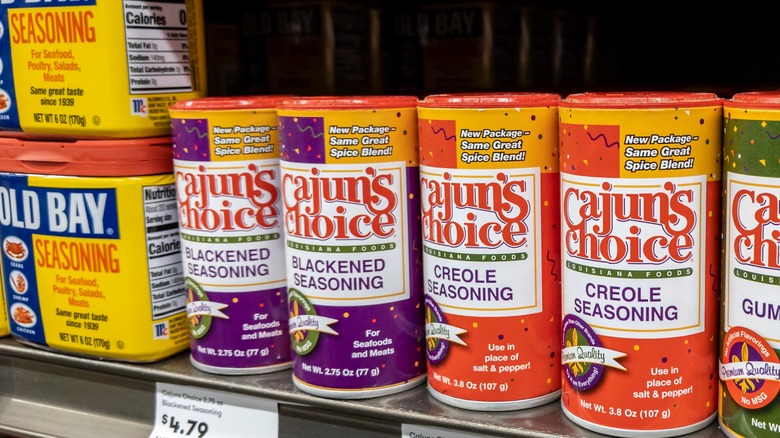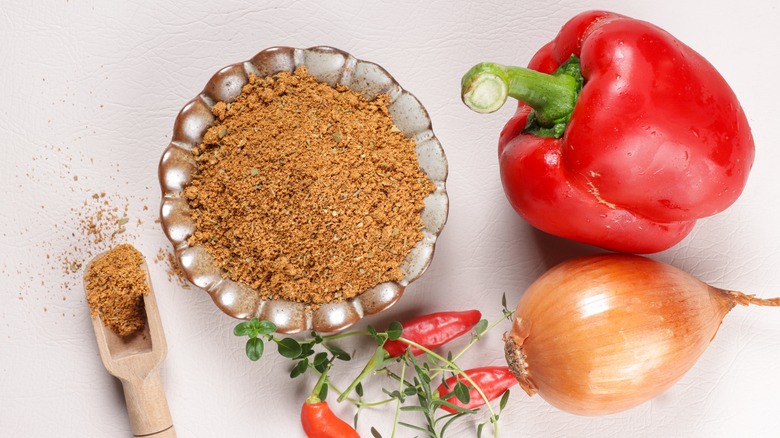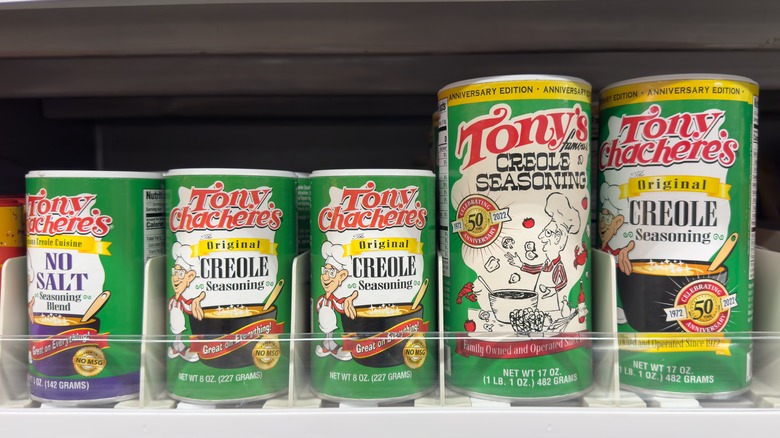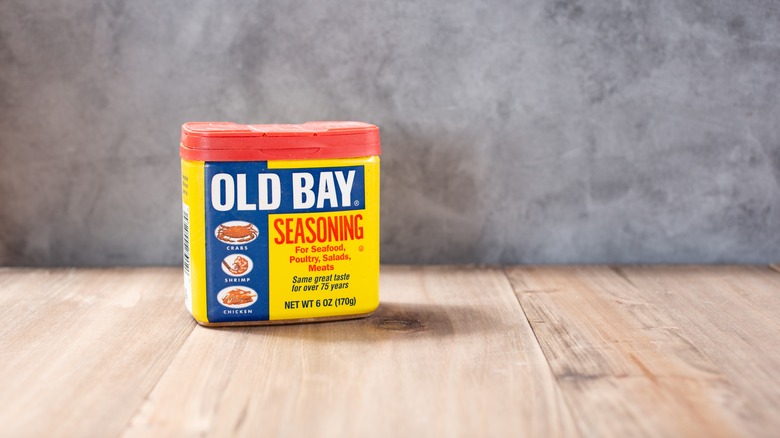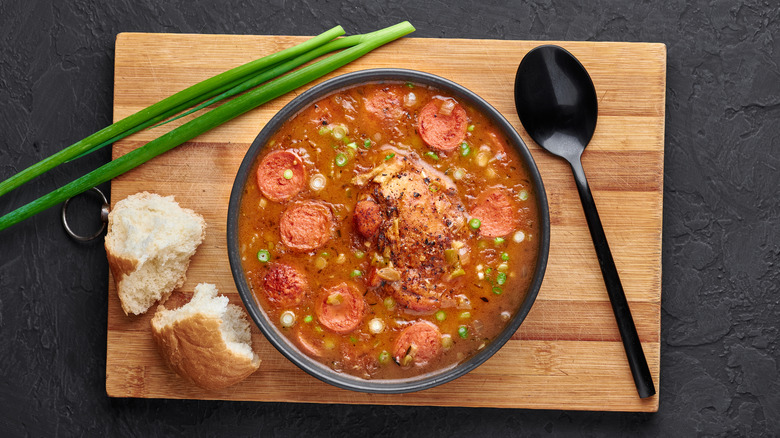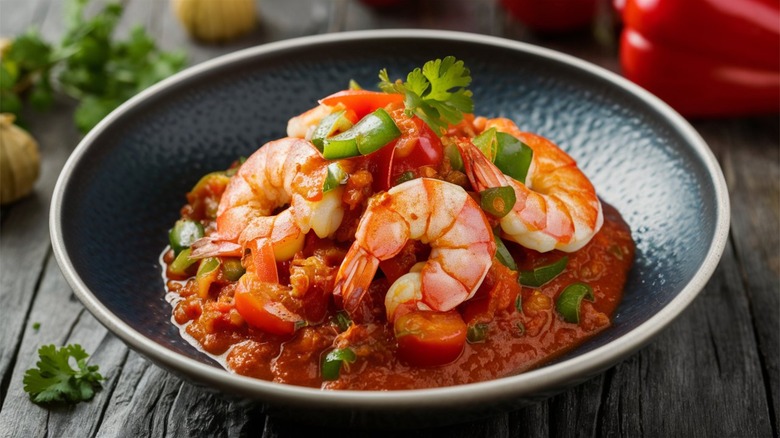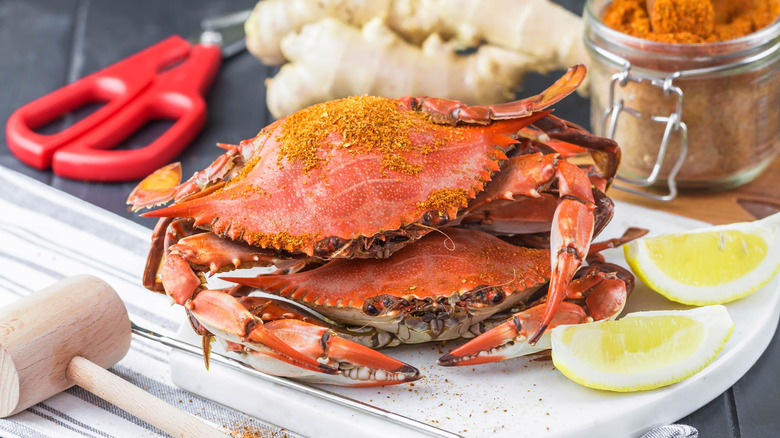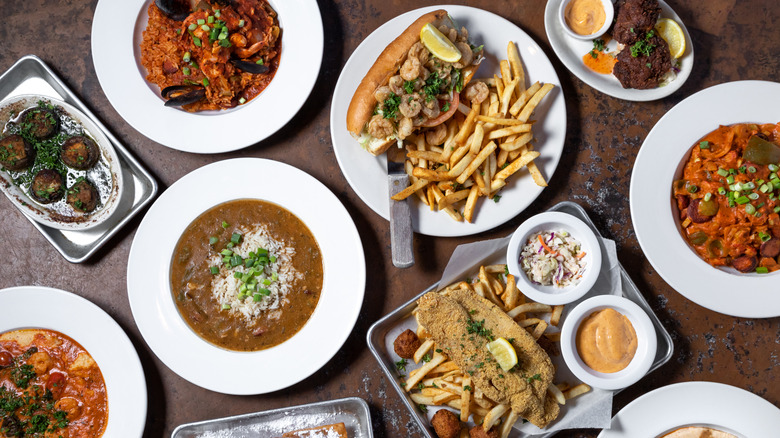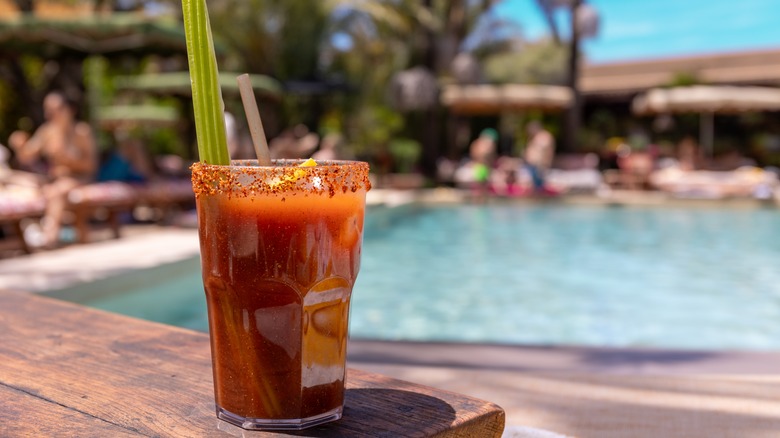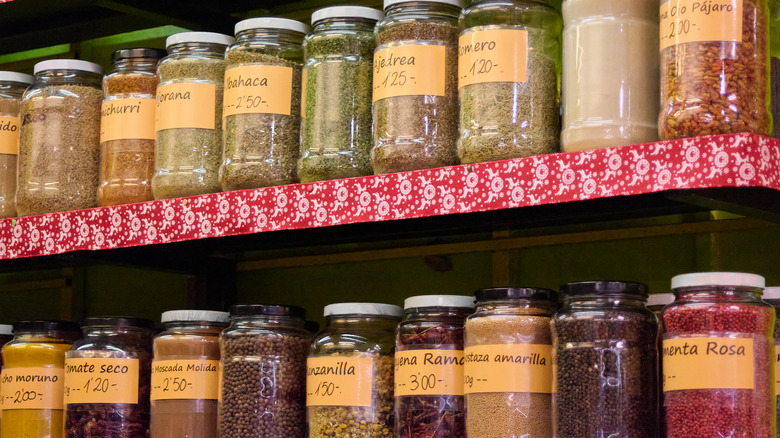Cajun, Creole, And Old Bay Seasonings: What's The Difference?
When it comes to seasoning food, spice blends are a convenient way of amping up flavor without a lot of extra effort. Among the most popular blends in the US are Cajun, Old Bay, and Creole seasonings. These regional specialties are commonly used similarly in recipes, ranging from classic seafood specialties to soups and stews. While they do share enough similarities that they can be used interchangeably, there are distinctions between them that can make them more or less suitable for a specific recipe, depending on what you are going for.
This is where my expertise comes in. As a chef with nearly 18 years of professional experience and a background in food anthropology, I consider myself a spice connoisseur. I relish in dissecting spice blends, researching how they came about, and determining what makes them unique. Doing so informs how I implement each into my culinary repertoire, empowering me with the knowledge and ability to do so with a more deft hand. Let's take a virtual trip across the globe, and throughout history, to discover what makes Cajun, Old Bay, and Creole seasonings different from one another.
What is Cajun seasoning?
Cajun seasoning is often associated with Louisiana, and more specifically with New Orleans. In reality, this spice blend should be identified with the rural populations of Louisiana and is traditionally a seasoning ideally suited for more rustic recipes. The blend, which can be obtained commercially or made from scratch, is characterized as being quite spicy, though this is dependent on the precise combination of ingredients utilized.
A majority of Cajun seasoning blends lean heavily on the use of peppers of various kinds, including cayenne, white, and black peppercorns. These are typically supplemented with aromatic garlic or onion, oregano, thyme, and sweet or smoked paprika. This is a spice blend that promises rich, smoky, savory notes that can amplify any recipe, helping to transform otherwise common ingredients into something quite extraordinary — a feature that is indicative of its country origins.
The terms "blackened," or "blackening," seasoning are often used synonymously with Cajun blends, as they rely heavily on cayenne pepper, paprika, and herbs, like oregano and thyme. They also refer to a culinary technique itself, that can apply to both Cajun and Creole dishes. The key aspect of this culinary tradition is the curation of a deep, dark char on meat, seafood, or vegetables, which are cooked over a high heat. The chili peppers and paprika are integral to the development of the dark color and intense flavor of dishes that are blackened.
What is Creole seasoning?
Another spice blend that is associated with Louisiana, and New Orleans in particular, is Creole seasoning. This combination is also one that comes in many iterations, depending on the person making it or the commercial brand being purchased. Where Cajun seasoning is defined by its rustic roots, Creole seasoning is a product of more refined, sophisticated traditions, fusing the many people who inhabited the region with particular roots in elite French culinary heritage.
When comparing Cajun and Creole seasonings, the latter is less spicy and relies more heavily on dried herbs for flavor. A Creole seasoning blend generally lacks cayenne pepper, gaining its crimson hue from a mild, versus smoked, paprika. Other ingredients may include oregano, thyme, bay leaves, basil, and celery powder. One of the most well-known commercial varieties of Creole seasoning comes from Tony Chachere's, whose legacy is etched in the history of the melting pot that is the Louisiana food scene.
What is Old Bay seasoning?
Unlike Cajun or Creole seasonings, Old Bay is a blend that does not hail from the state of Louisiana, nor is it a combination with fluid ingredients that identifies an entire culture or culinary tradition. Old Bay is a proprietary spice blend containing 18 distinct ingredients, including celery seed, paprika, mustard, salt, red pepper, and black pepper, that is often used to flavor the broth for a classic seafood boil. The blend hails from the Chesapeake Bay area of Maryland where it was invented in 1939. This brand was acquired by McCormick in 1990, where it has remained a staple ever since.
Though there are many knock-offs of Old Bay, it is distinct and one-of-a-kind. Its characteristic combination of bitter, sweet, floral, and spicy elements give it a complexity that can elevate many dishes, from crab cakes to cocktails, like a classic Bloody Mary. And, while Old Bay has more ingredients in it than either Cajun or Creole seasonings, it can easily be substituted with either for many recipes.
Cajun cuisine is more rustic in origin
To truly appreciate Cajun seasoning and cuisine, it is necessary to dive more deeply into the origins of the people who settled in this region. The term "Cajun" is derived from "Acadian." Acadians were the first inhabitants of what is now known as Nova Scotia. The migrants who came here in the 17th century were from the Northwestern part of France. They were largely Catholic and spoke a distinctive language heavily influenced by Occitan, Celtic, and Norse dialects. These hearty people adapted to the local environment, becoming prolific hunters and trappers.
When the British took over control of this region, the Acadians refused to relinquish their traditions, resulting in what became known as "Le Grand Dérangement," a period, beginning in 1755, during which the Acadians were expelled and relocated to Southern Louisiana. What resulted was a distinct culture that was part French and part the result of intermingling with natives and other migrants to rural areas of Louisiana.
The food of these people was resourceful, stick-to-your-ribs, frugal, and rustic, taking advantage of the bounty of the area, including pork, chicken, corn, rice, and vegetables, like okra. The primary philosophy of this cuisine became "nose-to-tail" cooking, meaning nothing goes to waste. As it has evolved over the centuries, Cajun cooking has maintained its commitment to tradition, celebrating the culture of its ancestors, while becoming well-regarded as one of the most uniquely seasoned and robust culinary traditions in America.
Creole cuisine tends to be more sophisticated
Creole seasoning can also be understood more completely through the lens of the history of settlers in Louisiana, and in stark contrast to Cajuns. The term itself derives from the Spanish "criar," which means "to raise." More specifically, Creole describes anyone who was born to migrant parents in the 1700s, and were brought up in what is the region surrounding modern-day New Orleans, Louisiana. A majority of these individuals descended from European people, particularly those of French elite lineage, and many were the offspring of enslaved Africans. Like Cajuns, they tended to be Catholic, though they spoke a more proper iteration of French.
This culture was bound by tradition and by a unique identity, represented most distinctly in the architecture and food produced by the inhabitants of this melting pot. Creole cuisine is most well defined by its sophistication. The techniques are more classically rooted in French haute cuisine, but the ingredients are decidedly local. Elements of indigenous traditions fuse with Caribbean and African influences, resulting in a highly-flavored, refined culinary landscape that is reminiscent of Cajun cuisine, yet distinctly its own. Creole culture and cuisine seeks to differentiate itself, while celebrating what makes this region special. And, its legacy of a historically well-to-do group of migrants who relied upon slave labor to produce elevated dishes is evident throughout the recipes that are considered classics.
Old Bay was invented by a Jewish immigrant fleeing Nazi Germany
While Old Bay seasoning is not representative of an entire group of people and their history or culture, it does have a unique origin story. This spice blend may have been invented in Maryland, but its creator is a Jewish immigrant who fled Germany during World War II. Gustav Brunn was a spice purveyor in his native Germany, before soldiers detained him and his family on Kristallnacht in 1938. They were subsequently sent to the concentration camp at Buchenwa, from where they escaped before defecting to America.
Once the family settled in Maryland, Brunn re-established his spice business stateside, opening the Baltimore Spice Company. It was here in 1939, that he developed the first recipe for what would eventually become Old Bay seasoning, based on what he observed along the docks of the Chesapeake Bay. First dubbed "Delicious Brand Shrimp and Crab Seasoning," this blend of 18 different herbs and spices was eventually renamed after the Old Bay passenger line of ships. Brunn lived until 1985, after which the Old Bay brand was acquired by McCormick & Company, Inc. in 1990. What began as the brainchild of a Jewish man trying to survive, has become a part of the identity of Marylanders, and something of a household name, across the US.
Cajun and Creole dishes are similar
Part of the confusion surrounding the differences between Cajun and Creole seasonings is that the dishes they are used in are often similar. Though Cajun and Creole cultures are distinct from each other, they grew up alongside one another in the same geographical area, meaning the fundamental ingredients involved in these culinary traditions are the same. They are also both the product of strong Catholic faith and tradition, which is made up of many festivals and rituals, such as Mardi Gras, that are often celebrated by consuming or abstaining from specific foods.
At the heart of many of these dishes are basics, like the "Cajun Holy Trinity," a combination of aromatics including onions, celery, and bell peppers, abundant fresh seafood, rice, and luxurious sauces made from either a light or dark roux. Common recipes seen across both cuisines include po'boy sandwiches, gumbo, etouffee, red beans and rice, and seafood boils containing locally-sourced shrimp and crawfish. What often differentiates the Cajun versus Creole iteration of a dish is the use of tomatoes, more refined ingredients, like butter versus oil in a roux, and a more diverse combination of herbs and spices, which are all hallmarks of the latter. Where Cajun dishes tend to be spicier and more aggressively seasoned, Creole dishes are more tempered in their use of seasonings, though no less flavorful.
Old Bay is for more than just seafood
While Old Bay seasoning is well known for its use in classic seafood boils, its unique combination of bitter, sweet, floral, and pungent spices can easily transform any dish. In fact, this spice blend is the foundation for many recipes, from chicken or pizza to pasta and salads. Indeed, creative chefs have implemented it in recipes for appetizers, entrées, side dishes, and even desserts, highlighting the complexity and versatility of this seasoning.
One festive way to use Old Bay seasoning is as a topping for popcorn. It can elevate this popular snack from something relatively mundane to a spicy, savory, party-in-your-mouth. It is also ideal as a topping for french fries, baked potatoes, or any other iteration of a spud you can imagine. Old Bay poutine anyone? Lastly, try turning it into a compound butter. While this condiment is perfect for any kind of seafood, it is a delightful way to elevate vegetables, steaks, crusty bread, and more. The possibilities for Old Bay seasoning are only limited by your creativity in the kitchen.
The key to maximizing the flavor of Cajun, Old Bay, and Creole seasonings is how you store them
Although there is no hard and fast rule against using expired seasonings, it is important to note that spices can deteriorate over time. As they are exposed to the elements, particularly heat, light, and oxygen, spices will begin to become dull in color, aroma, and flavor. The key to maximizing the quality of your spices and seasoning blends is to store them properly.
Most spices are sold in sealed glass jars, which can be stored as-is. That said, if spices are packaged in plastic containers or bags, you will want to transfer them to a metal or glass jar to avoid exposure to the elements and the absorption of a synthetic odor that can taint them. Once your seasonings and spices are in a safe container, they should be kept in the pantry or a cupboard that is cool, dark, and lacking in excess humidity.
While spice drawers located next to the oven are convenient, they are not the best place for delicate seasonings to be stored. The heat will transfer to your spices, resulting in faster deterioration. Additionally, while it may seem easier to keep spices on the countertop for quick access, this can expose them to the elements, moisture, and cause contamination from other ingredients. Lastly, if you transfer spices from their original container, label them clearly with the date of purchase to indicate which ones to use first.
